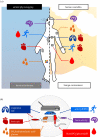Future trends in measuring physiology in free-living animals
- PMID: 34176330
- PMCID: PMC8237165
- DOI: 10.1098/rstb.2020.0230
Future trends in measuring physiology in free-living animals
Abstract
Thus far, ecophysiology research has predominantly been conducted within controlled laboratory-based environments, owing to a mismatch between the recording technologies available for physiological monitoring in wild animals and the suite of behaviours and environments they need to withstand, without unduly affecting subjects. While it is possible to record some physiological variables for free-living animals using animal-attached logging devices, including inertial-measurement, heart-rate and temperature loggers, the field is still in its infancy. In this opinion piece, we review the most important future research directions for advancing the field of 'physiologging' in wild animals, including the technological development that we anticipate will be required, and the fiscal and ethical challenges that must be overcome. Non-invasive, multi-sensor miniature devices are ubiquitous in the world of human health and fitness monitoring, creating invaluable opportunities for animal and human physiologging to drive synergistic advances. We argue that by capitalizing on the research efforts and advancements made in the development of human wearables, it will be possible to design the non-invasive loggers needed by ecophysiologists to collect accurate physiological data from free-ranging animals ethically and with an absolute minimum of impact. In turn, findings have the capacity to foster transformative advances in human health monitoring. Thus, we invite biomedical engineers and researchers to collaborate with the animal-tagging community to drive forward the advancements necessary to realize the full potential of both fields. This article is part of the theme issue 'Measuring physiology in free-living animals (Part II)'.
Keywords: artificial intelligence; health management; photoplethysmography; sensing technology; wearable devices.
Figures

Similar articles
-
A brief introduction to the analysis of time-series data from biologging studies.Philos Trans R Soc Lond B Biol Sci. 2021 Aug 16;376(1831):20200227. doi: 10.1098/rstb.2020.0227. Epub 2021 Jun 28. Philos Trans R Soc Lond B Biol Sci. 2021. PMID: 34176325 Free PMC article. Review.
-
What is physiologging? Introduction to the theme issue, part 2.Philos Trans R Soc Lond B Biol Sci. 2021 Aug 16;376(1831):20210028. doi: 10.1098/rstb.2021.0028. Epub 2021 Jun 28. Philos Trans R Soc Lond B Biol Sci. 2021. PMID: 34176329 Free PMC article.
-
Introduction to the theme issue: Measuring physiology in free-living animals.Philos Trans R Soc Lond B Biol Sci. 2021 Aug 2;376(1830):20200210. doi: 10.1098/rstb.2020.0210. Epub 2021 Jun 14. Philos Trans R Soc Lond B Biol Sci. 2021. PMID: 34121463 Free PMC article.
-
Animal tag technology keeps coming of age: an engineering perspective.Philos Trans R Soc Lond B Biol Sci. 2021 Aug 16;376(1831):20200229. doi: 10.1098/rstb.2020.0229. Epub 2021 Jun 28. Philos Trans R Soc Lond B Biol Sci. 2021. PMID: 34176328 Free PMC article.
-
Recent advances in biomedical, biosensor and clinical measurement devices for use in humans and the potential application of these technologies for the study of physiology and disease in wild animals.Philos Trans R Soc Lond B Biol Sci. 2021 Aug 16;376(1831):20200228. doi: 10.1098/rstb.2020.0228. Epub 2021 Jun 28. Philos Trans R Soc Lond B Biol Sci. 2021. PMID: 34176326 Free PMC article. Review.
Cited by
-
Fieldwork on animals living in extreme conditions as a source of biomedical innovation.Sci One Health. 2024 Nov 27;4:100096. doi: 10.1016/j.soh.2024.100096. eCollection 2025. Sci One Health. 2024. PMID: 39877680 Free PMC article. Review.
-
Near-Infrared Spectroscopy as a Tool for Marine Mammal Research and Care.Front Physiol. 2022 Jan 17;12:816701. doi: 10.3389/fphys.2021.816701. eCollection 2021. Front Physiol. 2022. PMID: 35111080 Free PMC article.
-
A brief introduction to the analysis of time-series data from biologging studies.Philos Trans R Soc Lond B Biol Sci. 2021 Aug 16;376(1831):20200227. doi: 10.1098/rstb.2020.0227. Epub 2021 Jun 28. Philos Trans R Soc Lond B Biol Sci. 2021. PMID: 34176325 Free PMC article. Review.
-
The study of social animal migrations: a synthesis of the past and guidelines for future research.Proc Biol Sci. 2025 Jun;292(2049):20242726. doi: 10.1098/rspb.2024.2726. Epub 2025 Jun 18. Proc Biol Sci. 2025. PMID: 40527454 Free PMC article. Review.
-
Accelerometer-based analyses of animal sleep patterns.Elife. 2022 Mar 8;11:e77349. doi: 10.7554/eLife.77349. Elife. 2022. PMID: 35258454 Free PMC article.
References
MeSH terms
LinkOut - more resources
Full Text Sources

